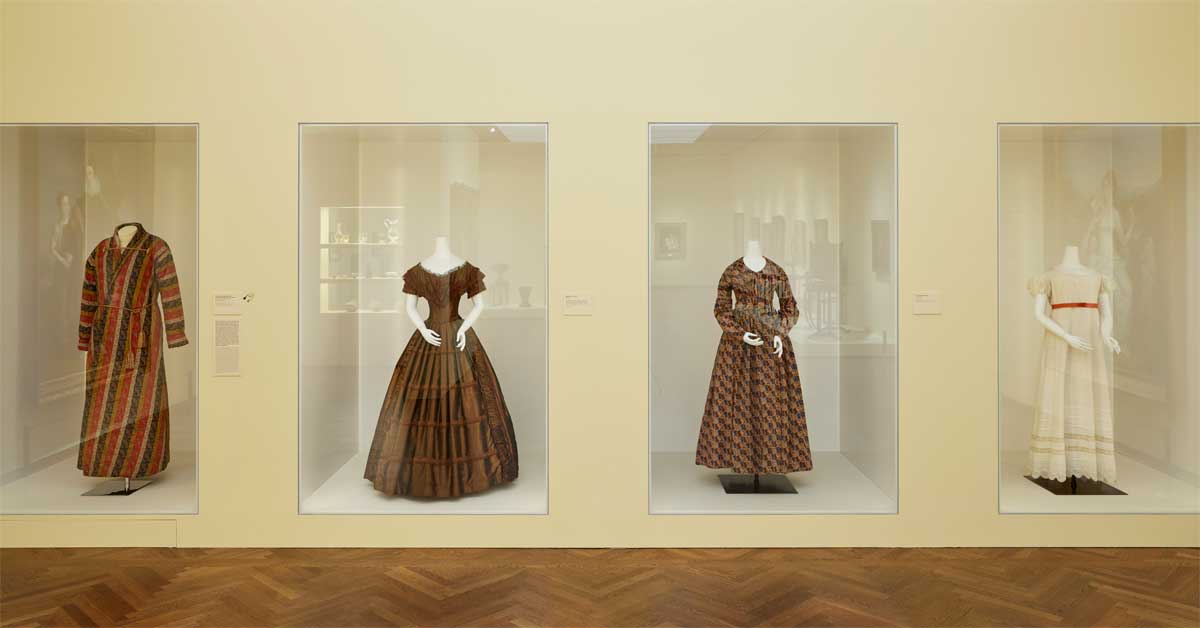

24 July 2025  Sometimes We Wait Too LongFashion.at's visit to the exhibition Biedermeier – The Rise of an Era at the Leopold Museum yesterday was one of those moments that calls for a slight self-reproach. The show opened in April, and it closes on July 27 – only a few days remain to catch this well-curated journey through a pivotal historical period. But it's never too late for a worthwhile exhibition. Fashion.at now casts a belated but focused eye on this rich and multi-layered show, which includes—though only in passing—some notable pieces of fashion and textiles.What Biedermeier Stands ForThe Biedermeier period, spanning roughly from 1815 to 1848, is often associated with political suppression, private retreat, and a flourishing of the arts in domestic and personal spheres. Yet it was also an age of rapid change: industrial progress, technical inventions such as the steam engine and railways, and the rise of the textile industry began reshaping the very fabric of society. Tourism emerged, driven by improved travel networks and a growing curiosity about the world beyond.The exhibition opens with a room featuring, alongside paintings and ceramics, technical drawings of the machinery used to produce Thonet furniture — a clear nod to the industrial foundations of the Biedermeier era.Among the paintings on display are works by renowned artists like Ferdinand Georg Waldmüller and Rudolf von Alt, as well as striking portraits by Johann Baptist Reiter, whose name may be less well known internationally but whose work stands tall among the Viennese masters. The exhibition features several landscape views of travel destinations not only from Austria, but also from the Swiss Matterhorn, New York as seen from Williamsburg, Rio de Janeiro, and even Gaza — the latter captured by Georg Döbler around 1830. Fashion and Textiles: Highlights and GapsThough textiles and fashion are not the central theme, they do make appearances throughout the exhibition. Musterkarten, or textile swatch boards, for cotton and plush-like 'Felpel' fabrics — mark a tactile moment in the otherwise painterly flow — even if touching them was, of course, not possible. Are there too few of these moments? Perhaps. Similarly, the few garments and costume pieces, though evocative, may leave fashion history enthusiasts wanting more.A particularly insightful part of the exhibition contextualizes Vienna's Seidengasse (Silk Lane), which was named after the silk trade that once flourished in the city. As the exhibition wall texts explain, the silk industry was lucrative enough to give rise to the name Brillantengrund, which refers to the Vienna neighborhood surrounding Seidengasse. When arriving at these stations, Fashion.at wished for another room – one filled with more fabric designs, industrial context, and profiles of textile producers such as the Gebrüder Mestrozi. Viewing more of their work and understanding the design's usage in clothing and interior items could have offered deeper insight. But the fact that such thoughts arise speaks to the success of the show: it has opened a new mental room, triggering curiosity that extends far beyond the museum walls. A Window Into an Era: Past Patterns, Future ShiftsBiedermeier – The Rise of an Era is not merely a historical overview; it's an atmospheric reconstruction of a time that resonates surprisingly with today's cultural shifts. As modern life increasingly turns toward the home and the personal, the parallels with early 19th-century domestic aesthetics and inward retreat become tangible. Just as the industrial revolution brought mechanization into daily life—reshaping labor, leisure, and identity—the present moment, defined by artificial intelligence and emerging physical AI systems, is poised to similarly transform society. From automation in manufacturing to intelligent agents in homes and workplaces, the echoes of past transitions remind us that we are again standing at the threshold of a cultural and technological reordering. The Biedermeier response—refocusing on the private sphere and aesthetics of simplicity—feels unexpectedly contemporary.Image: Exhibition view of 'Biedermeier – The Rise of an Era' at the Leopold Museum, Vienna. The photo shows four original garments from the Biedermeier period, displayed in a minimalist setting. © Leopold Museum, Vienna, Photo: Leni Deinhardstein |